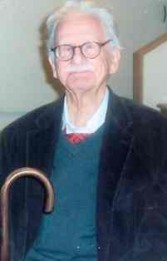William Lee Cumming
March 3, 1917 - November 22, 2010

Obituary
When preparing for a 2008 exhibition of his paintings, William Cumming, a spirited and colorful icon of Northwest art, said, ‘This might be my last show, considering that I am 91 years of age. On the other hand, it might not, considering my arrogant refusal to act my age.’
It was, in fact, the last solo show for the artist, who died Nov. 22 of congestive heart failure at age 93, leaving behind vibrant works of art that blend astute social observation with stunning abstraction.
Born in 1917 in Montana into a family with a Scottish, Calvinist and Christian Scientist background, Mr. Cumming and his family moved to Tukwila in 1924. Deciding at an early age that he was an artist, Mr. Cumming was initially self-taught, learning academic drawing through a correspondence school and exploring art history at the public library.
Mr. Cumming is best known as the youngest member of the Northwest School, the loosely affiliated group of passionate artists – Mark Tobey, Kenneth Callahan and Morris Graves – who staked a claim for modern, expressive art in this region during the 1930s, ’40s and ’50s. For Mr. Cumming, the older men – and their circles of family and friends – truly did serve as a kind of school as he felt his way toward a life devoted to art.
Callahan once recalled, ‘My first exposure to Bill Cumming was at some little gathering. Bill had brought some paintings to look at – nude females in brilliant color, like the French school. He was also composing music and writing poetry. He was very alive, very bright, very interested in the whole art scene.’
In his 1984 memoir, ‘Sketchbook,’ Mr. Cumming recounted that the poet Margaret Callahan, Kenneth’s wife, gave him pivotal advice, telling him to abandon painting ‘trivial little nudes with shoe-button eyes trying to look like Parisian chippies.’ Instead, she urged him to embrace his gift for capturing the movement and feeling of real life.
Taking this advice and, over time, infusing his paintings and prints with his signature contrasts of color, line and pattern, Mr. Cumming became known for his lively and intimate views of ordinary people engaged in daily life.
Mr. Cumming was a keen observer of the light in the Northwest and the activities of Seattle or his various places of residence – including the horse ranch where he lived for more than 15 years with a former wife, Sue Kruger.
However, Mr. Cumming’s vivacious colors and slightly abstracted forms render the scenes less specific, less local.
Likewise, Mr. Cumming captured the believability of movement and gesture and often painted his figures from the back or with unseen faces.
Kathleen Moles, curator of exhibitions at the Museum of Northwest Art in La Conner, says ‘the anonymity of his figures made them universal and accessible, and their vivid colors drew the viewer into what were at times less than happy scenes reflecting the social and economic realities of mid-20th-century life.’
Despite early successes – including a solo exhibition at the Seattle Art Museum in 1941 – Mr. Cumming suffered many setbacks because of his health, his politics or his cantankerous nature. Biographer Deloris Tarzan Ament relates that he spent most of World War II in a sanitarium with hemorrhaging lungs caused by tuberculosis, a disease that led to multiple surgeries and weakened health.
Mr. Cumming’s career was also jeopardized by his participation in the Communist Party, which he joined in 1945 after reading Marx, Engels and Lenin while hospitalized. At age 40, after years of being blacklisted, Mr. Cumming decided to renounce his involvement with communism and to recommit himself to his health and his art.
He once said, ‘I decided the only way for me to earn a living was to go with my only skill. I had to be a painter famous enough to make a living at it.’
During the 1950s, Mr. Cumming’s densely luminous canvases met with great success, winning prizes and entering private and institutional collections. The Seattle Art Museum mounted a second solo show in 1961.
According to Mr. Cumming’s longtime friend, writer Tom Robbins, ‘Much of the power – much of the appeal, frankly – of Cumming’s work is a result of its expressive ambiguity. A Cumming painting is both personal and populist, abstract and literal, hard-nosed and romantic.’
Mr. Cumming had been an art instructor at the Burnley School of Professional Art, which became the Art Institute of Seattle. He also taught at Cornish College of the Arts.
His love of teaching paralleled his love of communicating through paint. John Braseth, a close friend and the director of Woodside/Braseth Gallery, which often exhibited Mr. Cumming’s work, said, ‘Bill was a gifted teacher. He actively taught until he was 91 and still gave painting workshops at his home. He was going to teach the morning he passed away … so dedicated.’
Mr. Cumming was married seven times. He is survived by his wife, Dena Lee Cumming, and former wives Sue Cumming-Schultz and Roxanne Johnson-Cumming. He is also survived by his children: Kevin Woods, Phillip Cumming Arnautoff, Claudia Cumming, Karen Cumming, and Hugh Edmiston Cumming; and grandchildren and great-grandchildren.
A private memorial is planned. Remembrances can be sent to Real Change News, 219 First Ave. S., No. 220, Seattle, WA 98104.

Bill was an inspiration to countless students, staff, and faculty during his many years at The Art Institute of Seattle. He will be missed.
Bill inspired me to be an artist when I was a young man wondering what to do with myself. He made a great impact on me with color usage and design.
I will cherish these memories and through the artwork he created he lives on.